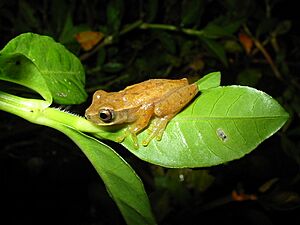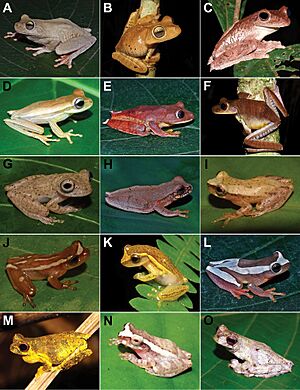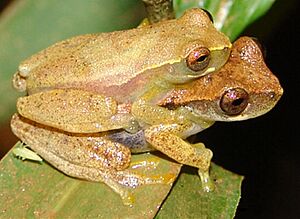Dendropsophus branneri facts for kids
Quick facts for kids Dendropsophus branneri |
|
|---|---|
 |
|
| Conservation status | |
| Scientific classification | |
| Synonyms | |
|
The Dendropsophus branneri is a small tree frog. It lives only in the Atlantic Forest of Brazil. This frog mainly eats arthropods, like insects. Bigger animals like snakes and birds hunt it. Even some spiders and giant water bugs prey on it.
Scientists currently say this frog is "least concern" for extinction. But its home is shrinking fast. People are building houses, farming, and cutting down trees. This frog is special because it can breed in different types of water. It uses both temporary puddles and permanent ponds. This helps it live in many places. Male D. branneri are known for their loud fighting calls. These calls are very different from their mating calls. Males also get into physical fights. They kick, push, and wrestle other males.
Contents
About the D. branneri Frog
What Does the Adult Frog Look Like?
Female D. branneri frogs are about 21.5 mm long. This is measured from their snout to their bottom. Males are a bit smaller, about 18 mm long. Their snout, or nose, is short and round. Both male and female frogs have small teeth. These teeth are on two tiny bumps in their mouth.
The skin on their throat and chest is smooth. Males have slightly bumpy skin there because of their vocal sacs. The skin on their belly is rough. Their back can be pinkish-red or light brown. They have a light brown stripe between their eyes. A black mark runs down their back to their lower body.
Both male and female frogs have a shiny white spot under each eye. This spot helps tell them apart from other similar frogs. Sometimes, a frog might not have these spots. Or it might only have one spot under one eye.
What Does the Tadpole Look Like?
D. branneri tadpoles have a body shaped like a violin. This means it's long when you look from above. It's flat when you look from the side. Their body is about half as tall as it is long. The body length is about a quarter of their total length, including the tail.
Their nostrils are small and oval-shaped. They are near the mouth and can be seen from the side or top. Their eyes are on the sides of their head. They are about half the width of their body apart. Each eye is about a quarter of the body's width.
Where the D. branneri Lives
The Dendropsophus branneri frog lives only in the mountains of Brazil. You can find them in the Atlantic Forest. This area stretches between Maranhão and Rio de Janeiro.
They are often found near the Rio Paraiba valley. They also live in the High Muriaé River regions. These frogs live in many different places. This includes savannas, shrublands, and grasslands. They also live in Restinga forests and high-up swamps. They can breed for a long time. They also adapt well to new places. This helps them live in many different natural areas. D. branneri also lives in plants around temporary and permanent ponds. They have learned to live in warm, dry places. This helps them spread out more. But having small living areas can still threaten them. This could raise their risk level on the IUCN Red List.
Protecting the D. branneri
Losing Their Homes
The Atlantic Forest is full of many different plants and animals. Over 400 species are known there. New ones are still being found. In 2013, a study found that frogs make up about 6.5% of the species there. The Atlantic Forest is now only 7% of its original size. This is because people are building homes, farming, and cutting down trees.
D. branneri lives in areas where humans have a big impact. This includes urban areas, gardens, and neighborhoods. Because they are losing so much of their natural home, these frogs have started living in human-changed areas. Scientists were surprised to find many frogs in the High Muriaé region. This was true even though humans had changed that area a lot.
In the mid-1800s, people started growing cacao in some Atlantic Forest areas. They used a method called "cabruca." This means planting cacao trees among native forest trees. Or they planted other trees like jackfruit. These cacao farms now cover large parts of the Atlantic Forest. Studies show that these farmed areas can still be home to frogs. But they are not as good as untouched forests.
Frog Family and Relatives
The Dendropsophus group has over 100 types of small frogs. They live in Central and South America. D. branneri used to be in the Hyla group. But it was moved to the Dendropsophus group. D. branneri looks like its close relatives, D. minusculus and D. oliveira. But you can tell them apart. D. branneri has unique white spots under its eyes. It also has special mating calls.
What the D. branneri Eats
D. branneri frogs use a "sit and wait" method to hunt. They wait for food to come close. They do not actively search for it. A study in Brazil looked at D. branneri living near coca farms. It showed they mostly eat arthropods.
Scientists looked inside their stomachs. They found three main types of prey. These were flies (about 15%), spiders (about 11%), and moth or butterfly larvae (about 11%). Other things found included cockroaches, true bugs, mites, ants, and grasshoppers. On average, each frog stomach had about 1.5 food items. The frog's size did not affect how much food it ate.
Scientists also found plant material in their stomachs. This was about 13% of the total food. It's not clear if they ate plants on purpose. It might have happened by accident while hunting insects. D. branneri was the first frog species studied this way. Scientists used a special method to check their stomach contents. This was for frogs smaller than 14.4 mm.
A related frog, Dendropsophus minutus, eats slightly different things. Spiders were the main food for D. minutus. Bigger frogs like Pithecopus rohdei and Phyllomedusa burmeisteri eat larger insects. This is probably because they have bigger mouths.
Mating and Breeding
Breeding Season
The D. branneri breeding season is from May to September. They are most active during the rainy season. During this time, the frogs gather together. They lay their eggs on the water's surface. D. branneri has a very long breeding season compared to other frogs.
Most frogs can only breed in temporary ponds. But D. branneri can breed in both temporary and permanent pools. This allows them to live in many different places. They can be found in savannas, shrublands, and grasslands. They also live in freshwater marshes. They even live in areas changed by humans, like pastures.
Male Frog Fights
Male D. branneri frogs are more likely to fight than other frog species. Most frogs try to avoid fights to prevent injuries. First, they might chase each other or make aggressive calls. These actions can turn into real fights. They might kick, push, or use their front legs to force an opponent down. Fights are usually avoided because they can cause injuries.
Scientists have studied their calls. Fighting calls are very different from mating calls. Fighting calls are lower in pitch. They last longer and have more pulses. For example, fighting calls are about 4866.50 Hz. Mating calls are about 6350 Hz. Fighting calls last about 0.2492 seconds. Mating calls last about 0.03 seconds. Fighting calls have about 62 pulses. Mating calls have about 4 pulses. We don't know why they make fighting calls. These calls use extra energy. They might also attract predators.
Enemies of the D. branneri
Predators
D. branneri frogs live and breed at the edges of ponds. This makes them easy targets for predators. Both water and land animals can hunt them. They are most at risk when they are changing from tadpoles to frogs. This is when they move from water to land.
Dendropsophus frogs are usually smaller than their predators. Or they are about the same size. Snakes, birds, and other frogs eat D. branneri. Giant water bugs and spiders also hunt them. Spiders often eat Dendropsophus frogs in the southern Atlantic Forest. A spider can be a predator or prey for D. branneri. It depends on the frog's size.
Most spiders that eat Dendropsophus frogs are from the Ctenidae family. Other spider families also hunt them. These include Araneidae and Lycosidae. One time, a large tarantula (84.12 mm) attacked a young Dendropsophus marinus (90.52 mm). This frog is a close relative of D. branneri. The frog had bite marks near its throat. Two hours later, the frog was still alive but couldn't move one eye or a back leg. Small frogs are likely an important food for Ctenidae spiders. This is especially true during the rainy season. Many temporary ponds are available then.
Parasites
Frogs are important in the life cycle of parasitic worms. This is because many animals eat frogs. And frogs eat many animals. This helps worms spread to many different hosts. A 2017 study looked for worms in tree frogs in the Brazilian Atlantic Forest. They found five different types of worms in 33 D. branneri frogs. They saw young parasitic roundworms in the frogs' stomachs and intestines. These worms were from the Brevimulticaecum and Porrocaecum groups.
Frog Sounds
Frog calls depend on their body and the environment. Things like their size and the humidity matter. Different studies give slightly different numbers for D. branneri calls. An older study found calls had 4 pulses. They lasted 0.03 seconds. The main sound frequency was 6.35 kHz. There was 0.37 seconds between calls. A newer study found calls had 11 pulses. They lasted 0.73 seconds. The main sound frequency was 6.7 kHz. They made 93 calls per minute.
Scientists looked at how calls relate to body size. They found no link between body length and the main sound frequency. Bigger frogs made fewer pulses per call. Longer frogs had longer pauses between calls.
The mating calls vary more between different male frogs. They don't vary as much within one frog. The rate at which they repeat calls is very different between males. This might help frogs recognize each other.
Images for kids







